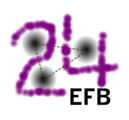Speaker
Description
A quiet revolution is occurring at the border between atomic physics and experimental quantum chemistry. Techniques for producing cold and ultracold molecules are enabling the study of chemical reactions and heavy-particle scattering at the quantum scattering limit with only a few partial waves contributing to the incident channel leading to the observation and even full control of state-to-state collisions in this regime.
We have developed a new R-matrix-based formalism for tackling problems involving low- and ultra-low energy collisions between heavy particles. This
formalism is completely general and could prove transformative in its scope. It is particularly appropriate for slow collisions occurring over deep potential energy wells which support many bound ro-vibrational states. These systems also support many quasibound or resonance states which make them hard to treat theoretically but offer the best prospects for novel physics.
The R-matrix method involves dividing space into an inner and outer region. In our method, the inner region exploits codes for performing high-accuracy variational nuclear-motion calculations of molecular spectra which have bee developed over many years in my group. The codes have already be used to compute wavefunctions up to and above dissociation. These variational nuclear motion methods are used to provide wavefunctions (both bound and continuum) for the whole system at short internuclear distances only. These collision-energy-independent, inner-region wavefunctions are then used to construct collision-energy-dependent R-matrices which can then be propagated to asymptotia.
Progress on the project will be described including results of test
calculations on ultra-low energy Ar -- Ar and O -- He collisions, as well as studies of polyatomic collision systems.
